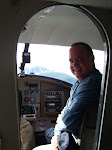
I took my first flight in the left seat of a 182 on Thursday. What a big step up from the older "steam gauge" 172s I've been flying. This 182 is a 2007 model with the G1000 avionics package. The only dials and gauges on the panel are backups in case of a complete electrical failure. I have to say it is a lot different, but still a lot of fun. Of course, I think flying just about anything would be fun.
All the fancy avionics aside, the real big difference in the 182 is the bigger engine in the nose. The plane is heavier, faster and requires a bit more attention to fly, or I should say to land. The 182 has a constant speed propeller. Which means the pilot no longer controls the speed of the propeller with engine RPM, he now controls the engine power and RPM with manifold pressure and propeller pitch. So, the pilot has picked up one more control to worry about. Actually, I broke even on the control knobs. This 182 is fuel injected, so I lost the carburetor heat control. Nope, forgot about the cowl flaps, I did pick up one more control knob. Pre-flight and engine run-up are more complex because of the G1000 and constant speed prop. There's simply more things to check, so I'm really going to have to pay attention to the check list any time I fly this plane.
 I took off from Whitted with CFI Pete and we flew out over the Gulf to play with the G1000 and the autopilot. This is the first time I've flow a plane equipped with an autopilot. We went through all the maneuvers to get me familiar with the flight characteristics of the 182, slow flight, stalls and steep turns. We did not do a power-on stall. Pete told me that the 235 HP engine in the 182 will let you pull the nose up so steep that you could enter a spin. I don't need any more of those. After that it was autopilot time. The autopilot with track the heading bug, the gps or the nav radios. It will climb or descend at a rate set by the pilot. The G1000 includes a flight director and the autopilot will follow that. Pretty much after take off, you can fly it just by pushing buttons until you're ready to land.
I took off from Whitted with CFI Pete and we flew out over the Gulf to play with the G1000 and the autopilot. This is the first time I've flow a plane equipped with an autopilot. We went through all the maneuvers to get me familiar with the flight characteristics of the 182, slow flight, stalls and steep turns. We did not do a power-on stall. Pete told me that the 235 HP engine in the 182 will let you pull the nose up so steep that you could enter a spin. I don't need any more of those. After that it was autopilot time. The autopilot with track the heading bug, the gps or the nav radios. It will climb or descend at a rate set by the pilot. The G1000 includes a flight director and the autopilot will follow that. Pretty much after take off, you can fly it just by pushing buttons until you're ready to land.Once done playing with the autopilot, we headed to St. Pete-Clearwater International Airport (PIE) for some touch-and-goes. Runway 25 was in use at Whitted, and since that puts your departure over downtown St. Pete, touch-and-goes are not allowed on 25. PIE wasn't too busy. A Coast Guard C-13o was doing some pattern work on runway 17L, so the tower put us on 22, and we had that runway to ourselves. The tower would switch me from right to left traffic, keeping me out of the C-130's way, I guess. The 182 looks pretty much like a 172, but the increase in weight, power and speed makes landing more interesting. First off, it doesn't slow down quickly as power is reduced. You have to plan your descent further ahead. It really doesn't want to slow down until you start lowering the flaps, but be careful one you do get it slow. Below 70 knots, it starts dropping out of the sky. You can't chop your throttle and glide in on final, like you can in a 172. It's necessary to maintain power until over the runway threshold and then slowly reduce engine power.
On the way back to Whitted, Pete asked me if I thought I was good with the 182. I think I need another hour or so with an instructor to nail those landings, then I'll be good. After the high-performance endorsement , I'll be able to rent any plane at Bay Air, except the Piper Arrow. That will give me more flexibility if something comes up last minute. Also, the 182 will let two couples take a dinner trip or something.






1 comment:
Sounds like a capable bird, Tony. I've flown in a 182 but not actually flown one. While I love hand-flying, an autopilot would sure be nice on long XCs, too.
Post a Comment